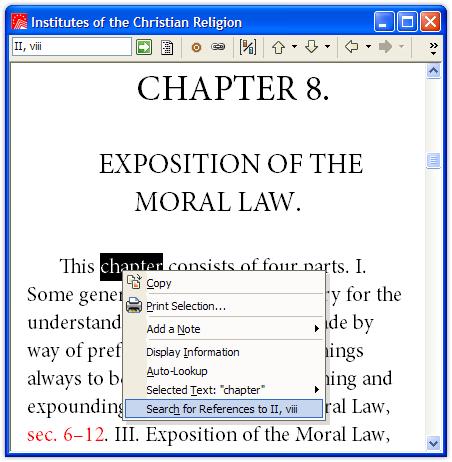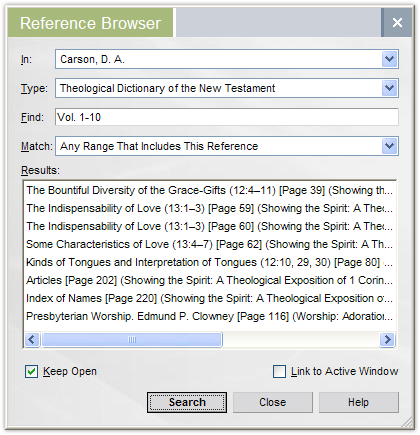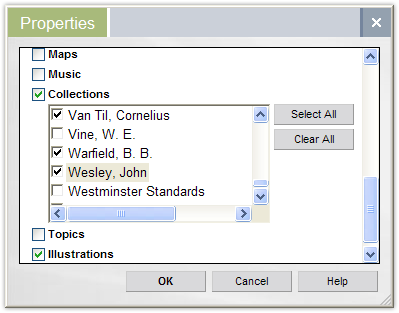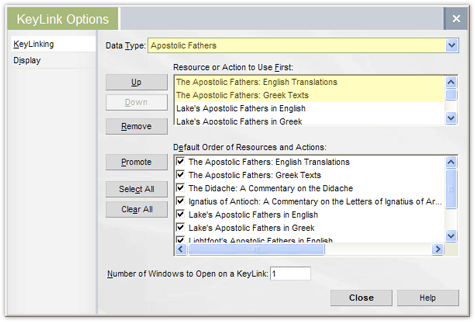Well, it’s about time to bring this series on data types to a close. It’s been a while since we talked about data types, so you might want to review by looking at some of the previous posts.
In this final post, we are going to look at reference data types and what they mean for more advanced studying and searching.
What Is a Reference Data Type?
To review, a reference data type is a scheme for referring to a location or range in a book (e.g., the Westminster Confession of Faith) or series of books (e.g., Barth’s Church Dogmatics).
The most common reference data type is the Bible (e.g, John 3:16). Others include Josephus (e.g, Antiquities 16.253), Philo (e.g., Hypothetica 11.18), the Apostolic Fathers (e.g., Ign Eph 2.2), Calvin’s Institutes of the Christian Religion (e.g., IV, xvi, 3), the Book of Concord (e.g., Formula of Concord: Epitome, art. viii, par. 39), the Westminster Confession of Faith (e.g., Chapter XIX, 6), BDF (e.g., BDF §272), Louw and Nida (e.g., LN 58.73), the Theological Wordbook of the Old Testament (e.g., no. 1768b), the Context of Scripture (e.g., COS 1.56), and Barth’s Kirchliche Dogmatic (e.g., KD I.1 p.352).
Since these and many other resources are data types, you (1) have greater control over what resources open when executing keylinks and (2) can perform very advanced searches in other books in your digital library that cite a particular data type.
Setting Up Keylink Targets for Reference Data Types
For each of these reference data types there may be more than one suitable keylink destination. For example, if you own the Apostolic Fathers in Greek and English (3 Editions, with Morphology), you can tell Libronix which version of the Apostolic Fathers to use when executing an Apostolic Fathers keylink (i.e., when looking up a reference in the Apostolic Fathers). You can even specify whether you’d like to see Greek or English by default.
To set up your preferred resources for various reference data types, go to Tools > Options > Keylink and select the appropriate data type from the drop-down menu.
Promote and prioritize the resources however you’d like.
Searching for Reference Data Types
There are several ways that you can perform advanced searches for reference data types.
1. Use the Right-Click Menu.
One way to search for a specific data type reference in another resource is to start in the resource that contains the reference that you want to search for and use the right-click menu. For example, if I’m at Calvin’s “Exposition of the Moral Law” in Book Two of his Institutes (i.e., II, viii), I can right click anywhere in that article and select “Search for References to II, viii.”

This will launch a library-wide search for other books in your library that cite this reference in Calvin’s Institutes. If you have a lot of books or know you want to search only a limited range of your resources, this is probably not the best way to do a search like this. What it does do for you, though, is provide you with the syntax for that search, which you can then use in a basic search. The syntax for this particular search is "cicr" in "II, viii".
2. Use the Basic Search.
To search a particular book or collection for a data type reference or range of references, you can use the basic search. The syntax is "data type" in "data type reference" (e.g., "Bible" in "John 3:16"). By using “in” your search will turn up ranges that include your reference. If you want to find the exact reference, use "data type" = "data type reference" (e.g., "Bible" = "John 3:16").
If you want to find all the places where a book or collection cites another resource, simple use the entire range of references in your search. Here are some examples:
- "KD" in "Die Kirchliche Dogmatik I-IV"
- "confess" in "The Confessions of St. Augustine, Book 1-13"
- "cicr" in "I-IV"
- "bible" in "Gen-Rev"
A search like "cicr" in "I-IV" in the Works of Van Til would allow you to use Van Til as a commentary of sorts on Calvin’s Institutes.

3. Use the Reference Browser.
If you don’t want to mess with hard-to-remember syntax, the Reference Browser makes performing searches like this even easier. Select (1) the book or collection you’d like to search, (2) the data type, (3) the reference or range to search for, and (4) whether to find the reference exactly or broader ranges that include that reference. If you are new to reference data type searching, the Reference Browser is definitely the best place to start.

Sometimes it can be difficult to know exactly what to enter into the Find box. Using the right-click menu as mentioned above or simply displaying the data type in the Active Index for the resource well help you figure this out.
4. Use the Passage Guide.
Finally, you can also use the Passage Guide to search one or more collections for Bible references. In the Passage Guide, select Properties and check the boxes next to any collections that you would like to have included in your Passage Guide search.

For more on searching for data types, see the article Exploring Logos Searching.
Other posts in this series:





